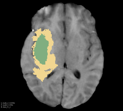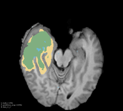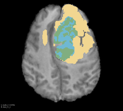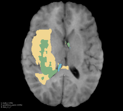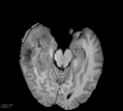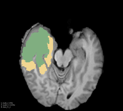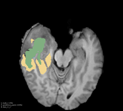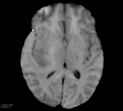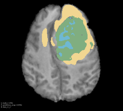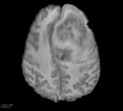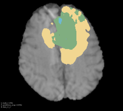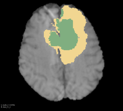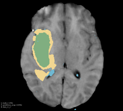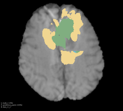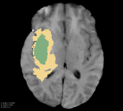Deep neural network models used for medical image segmentation are large because they are trained with high-resolution three-dimensional (3D) images. Graphics processing units (GPUs) are widely used to accelerate the trainings. However, the memory on a GPU is not large enough to train the models. A popular approach to tackling this problem is patch-based method, which divides a large image into small patches and trains the models with these small patches. However, this method would degrade the segmentation quality if a target object spans multiple patches. In this paper, we propose a novel approach for 3D medical image segmentation that utilizes the data-swapping, which swaps out intermediate data from GPU memory to CPU memory to enlarge the effective GPU memory size, for training high-resolution 3D medical images without patching. We carefully tuned parameters in the data-swapping method to obtain the best training performance for 3D U-Net, a widely used deep neural network model for medical image segmentation. We applied our tuning to train 3D U-Net with full-size images of 192 x 192 x 192 voxels in brain tumor dataset. As a result, communication overhead, which is the most important issue, was reduced by 17.1%. Compared with the patch-based method for patches of 128 x 128 x 128 voxels, our training for full-size images achieved improvement on the mean Dice score by 4.48% and 5.32 % for detecting whole tumor sub-region and tumor core sub-region, respectively. The total training time was reduced from 164 hours to 47 hours, resulting in 3.53 times of acceleration.
翻译:用于医学图像分解的深神经网络模型规模很大, 因为它们是高分辨率三维( 3D) 图像培训的。 图形处理器( GPU) 被广泛用于加速培训。 但是, 图形处理器( GPU) 的记忆量不够大, 不足以培训模型。 解决这一问题的流行方法是一种基于补丁的方法, 将大图像分为小片, 并用这些小片对模型进行培训。 但是, 如果目标对象跨过多个片段, 这种方法会降低分解质量 。 在本文中, 我们提出一个3D 医学图像分解的新方法, 使用全分辨率的3D 医疗图像分解器( 3D), 使用全尺寸的xx 192x 数据转换为 CPUP 存储器的中间数据, 以扩大有效的 GPU32 内存大小, 用于培训高分辨率 3D 医疗图象, 不补补补补。 我们仔细调整了数据方法的3D UNet, 一个广泛使用的深神经网络模型用于医学图像分解 4. 我们应用了3D UNet 的调用全尺寸的全尺寸图解图解的全尺寸图解图解图, 192x192192x192x192x192x区域, 的结果在中间平平平平平调了 。 。 。 。 。

